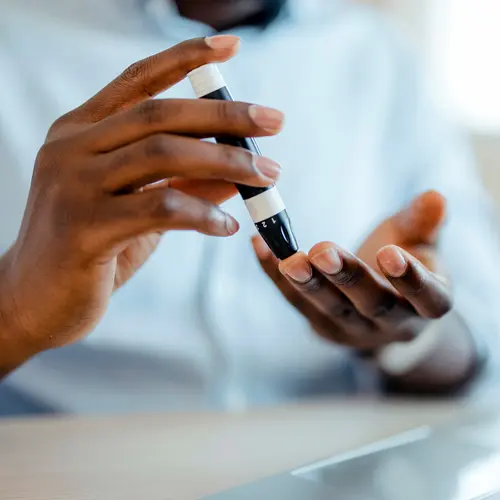If you have type 2 diabetes, your chances of getting gout are higher. And the same is true in reverse. Gout boosts your chance of diabetes.
Gout is a kind of arthritis that causes sudden pain and swelling in your joints. It usually shows up first in the big toe, but it can occur in other joints too. The pain can be intense.
Some things raise your risk for both diabetes and gout, but you can manage many of the causes of these conditions.
What Causes Gout?
Gout usually happens when uric acid builds up in the blood (a condition called hyperuricemia). This acid is a waste that your body makes when it breaks down purines, substances found in your body tissue and some foods. Normally, the acid dissolves in your blood, passes through your kidneys, and leaves when you pee.
If your body makes extra uric acid, or if the kidneys can’t clear enough of it, the levels of the acid in your blood get too high. With time, the acid forms crystals that get stuck in your joints or soft tissue. That’s what causes the painful symptoms.
A first attack of gout may last a week to 10 days. It’s estimated that almost 85% of people who have it once have another episode within 3 years. Gout often runs in families. So if a parent, brother, or sister has it, you might get it too.
The Gout-Diabetes Link
People with type 2 diabetes are more likely to have hyperuricemia, and people with gout and high uric acid may be more likely to get diabetes. Not everyone with hyperuricemia gets gout, but your chances go up as uric acid levels rise.
Type 2 diabetes happens when your body doesn’t use insulin well and sugar stays in the blood instead of moving into cells. This is called insulin resistance. Studies show this may play a role in the development of gout and hyperuricemia and may also make insulin resistance worse.
A 2010 study published in The American Journal of Medicine examined thousands of adults and their children. The researchers found that those with higher uric acid levels were more likely to get type 2 diabetes.
A 2014 study in the Annals of the Rheumatic Diseases found the gout-diabetes connection was especially strong in women. Researchers said that women with gout were 71% more likely to get diabetes than women without it.
There are other factors that play a role in both conditions, too:
Obesity. Almost 90% of people with type 2 diabetes are overweight or obese. People who are obese are four times more likely to get gout than a person of normal weight. Carrying extra pounds slows down your kidneys’ ability to remove uric acid.
Other health conditions. About 80% of people with type 2 diabetes also have high blood pressure. That raises acid levels and is also linked to insulin resistance. Gout and diabetes are linked to kidney damage and heart disease, too.
Age. If you’re older than 45, you have a bigger risk for both.
What Triggers Gout?
Something that causes a flare in one person might not do it in another. But common triggers include:
- Heavy alcohol use, especially drinking beer and hard liquor
- Foods high in purines, including red meat, organ meat (like liver), and some seafood, including shellfish
- Sugary sodas and foods with fructose, a type of sugar
- Some drugs used to treat high blood pressure, leg swelling, or heart failure
- Fasting and dehydration
If you think something may trigger gout for you, talk to your doctor about ways to avoid it.
Treatment for Gout
People with diabetes should have a uric acid level at or below 6 mg/dL to reduce the risk. Ask your doctor to test your blood if you don’t know your number.
Your doctor may suggest medication to help you make less uric acid or help your kidneys get rid of more of it.
Treatments may include:
- Uricosuric agents to help your body pass more uric acid
- Xanthine oxidase inhibitors to help your body make less uric acid
If you have a flare of gout, medications can ease pain and swelling. These include:
Colchicineis a gout medicine that’s most effective if taken right away. Stomach problems are common side effects, but more serious ones can happen too.
Corticosteroids, such as prednisone, are taken by mouth or can be injected into your joint. Another injected drug can help your body make corticosteroids naturally.
Nonsteroidal anti-inflammatory drugs (NSAIDS) include ibuprofen, indomethacin, and naproxen. Don’t take aspirin. It can make the pain worse.
Managing Gout and Diabetes
Lifestyle changes can lower uric acid and help control blood sugar.
Watch what you eat. Diet is a key to managing both conditions well. In addition to your diabetes-friendly diet, avoid certain foods and add others.
- Cut out or limit high-purine foods like red meat and seafood, including shrimp, lobster, mussels, anchovies, and sardines.
- Limit or eliminate alcohol to prevent another attack.
- Add dairy products like skim milk and low-fat yogurt, which may protect against gout.
Consider seeing a registered dietitian. They can put together an eating plan that suits your tastes and your needs.
Get moving. Regular exercise helps control blood sugar and can help you lose weight, which can help your body remove excess uric acid. Talk to your doctor about what kinds of activities can benefit both conditions.
Stay hydrated. It’s thought that drinking plenty of water can help flush out uric acid and keep your kidneys working well. A good goal is to down 64 ounces a day, roughly eight glasses. Drink more when you’re exercising.
Control other health problems. High blood pressure, kidney disease, and obesity raise uric acid levels and can bring on a gout flare. Make sure you’re seeing your doctor regularly and following your treatment plan if you have any of these conditions.
